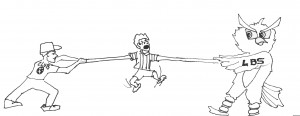However, since there is still a high priority on academic success, the level of competition suffers a blow, as compared to club sports.
For members of a club team, some of the main reasons to participate are: to better one’s skills, to pursue one’s sport at a more competitive level, and to expose one’s talents to the outside world.
Club athletes often market themselves to colleges, and even professional organizations, in hopes of being recruited and earning a scholarship.
However, while club athletes are furthering their talents — and possibly laying the groundwork for a collegiate or professional athletic career — they sometimes suffer.
For example, certain club organizations prohibit their players from competing on high school teams. This move is selfish, but also smart: coaches want to ensure that their players are entirely committed to the club.
They also don’t want to risk a player getting injured in a school game: this could threaten the player’s ability to play in club games and tournaments.
Because of these restrictions, school teams lose potential stars, and sometimes become desperate for players. However, the school isn’t the only body that suffers; the club athlete does not have the same experience of a high school athlete.
The club player doesn’t compete alongside peers and classmates, fighting together to bring respect and glory to the school.
Instead, he or she is surrounded by a group of individuals who play for the same team, but have different individual goals and objectives.
Fortunately, student-athletes at Laguna Blanca don’t have to worry about these restrictions: the school allows players to compete at the scholastic and club levels simultaneously.
Take the example of Laguna freshman, Tiana Bonn. Over the years, she has grown used to balancing school sports, her school work and playing for the Santa Barbara Soccer Club.
Although it makes managing her academic life more difficult, Tiana appreciates being able to play both club and school soccer: “Club soccer is where I go to improve my skills, but school soccer gives me the opportunity to practice with older and more advanced players.”
However, allowing students to compete at both levels can sometimes hurt school athletics; when club players miss practice or games due to club-level conflicts, the school team is hurt, no matter the player’s status on the school team.
These conflicts became a reality on Oct. 2, when the Laguna Blanca football team had to take on the Dunn School without quarterback Troy Ritter. Ritter, who plays club soccer year round as well as Laguna sports, had an important soccer game in Orange County.
“I didn’t want to miss either game, but since I want to play soccer in college, I put soccer first.”
Although Ritter’s absence made an impact, the Owls were still able to pull through, and silence Dunn 50-20. This is largely due to the leadership of this year’s seniors, like co-captain Jeffrey Nelson. “Luckily, we have a lot of skilled players this year who are able to move around positions. We very successfully ran the ball, and even without Troy, we had a good passing game.”
In this case, Ritter’s absence served as an eye-opener for Laguna’s sports teams. The school continues to support students in their athletic endeavors, club or school, but team captains have taken a greater responsibility for their players’ attendance and commitment.
All in all, club sports are a great way for players to further their athletic abilities. As long as club players honor their school commitments, there won’t be too many conflicts like the Homecoming Game.

































